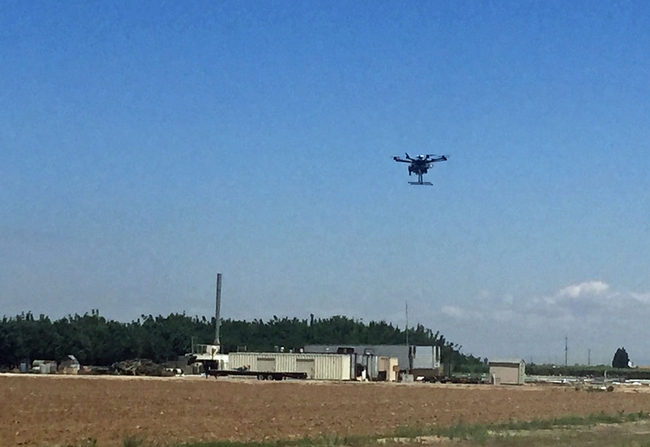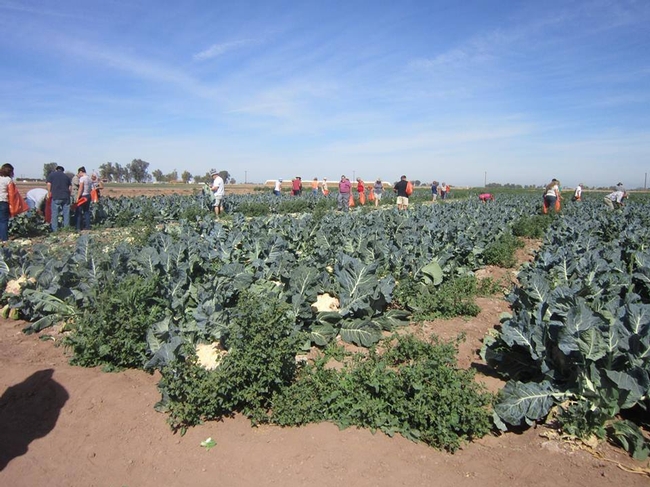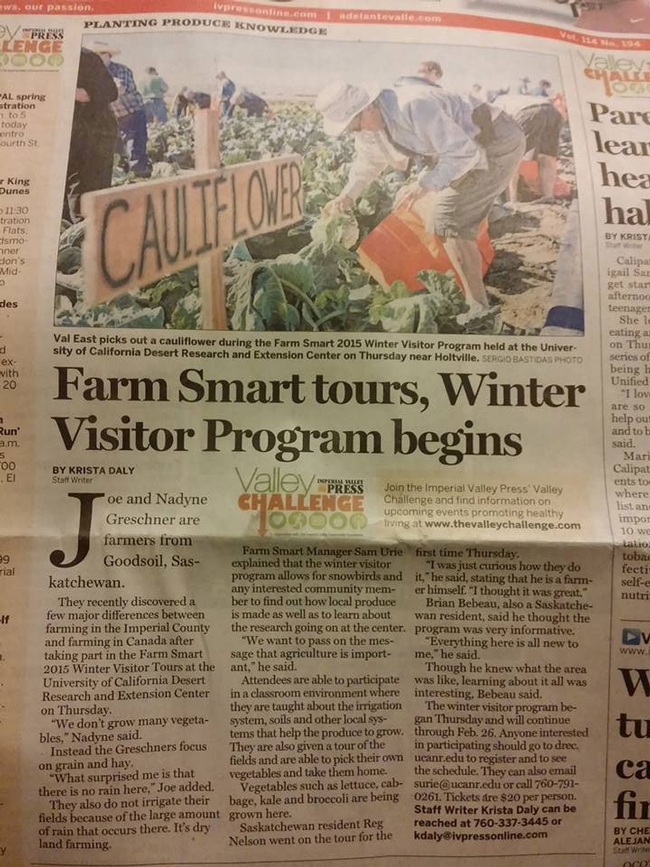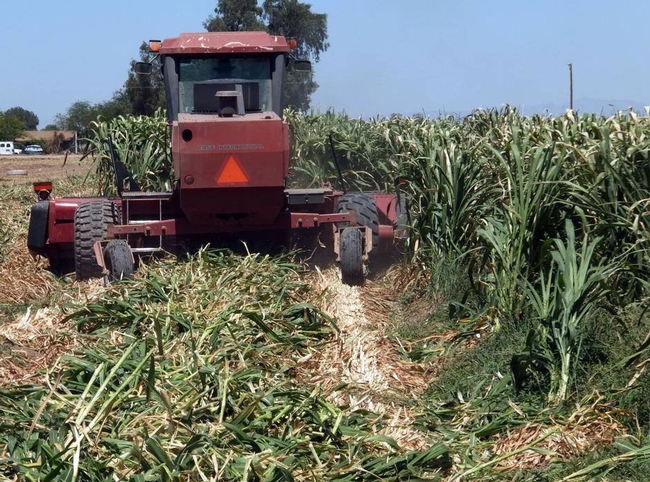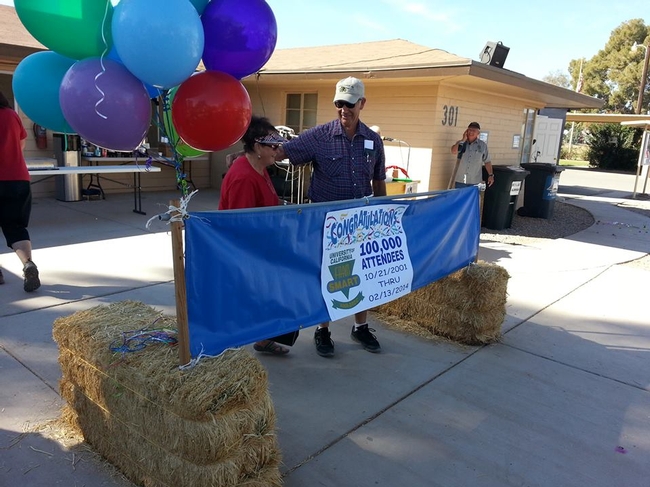Posts Tagged: Desert Research and Extension Center
Drone technology on display at UC research center
The UC Desert Research and Extension Center hosted a workshop for employees and local stakeholders on potential uses for drone technology in agriculture, reported Edwin Delgado in the Imperial Valley Press.
“The intent of this workshop is to start bringing the knowledge about unmanned aerial systems to the University of California Agricultural and Natural Resources division and the public at large,” said Sean Hogan, coordinator of Informatics Geographic Information Systems for UC ANR. “There is so much curiosity about it right now, it's a growing industry and there is a lot of concern and controversy about the misuses on it.”
The article said the UC system now has the green light to begin using drones. Hogan is holding workshops throughout the state to share his expertise with UC ANR employees and members of the community.
Desert Research and Extension Center director Jairo Diaz said the workshop was important because participants were able to see a demonstration of how the technology works and how it can be applied to the projects and research they are currently working on.
“These workshops that give growers and stakeholders can use in the area are very important because tech like this can help in the near future help find out different types of issues on the field like management of nutrients, water and find out to improve management of field,” Diaz said.
At the UC Kearney Agricultural Research and Extension Center last week, technicians tested a drone that will be used throughout the summer to collect growth data on 600 varieties of sorghum begin produced under different irrigation regimens. With imaging and lidar, the drone collects information on leaf area and biomass in half an hour that would take a full day for a person in the field.
Read more about the sorghum research at Kearney here.
UC's winter FARM SMART program kicks off at Desert facility
Each winter, thousands of "snow birds" land in the Southern California desert to enjoy the warm and dry climate. They are short-term refugees, many of them senior citizens, escaping cold weather in northern states and Canada. Winter visitors also have the opportunity to attend FARM SMART and learn about the food grown in the vicinity and shipped across the nation, reported Krista Daly in the Imperial Valley Press.
FARM SMART is offered in January and February each year. Attendees learn about irrigation and soils, pick vegetables to take home and enjoy a lunch of local produce.
"We want to pass on the message that agriculture is important," said Sam Urie, FARM SMART manager at the UC Desert Research and Extension Center in Holtville.
The tour was eye-opening for visitors Joe and Nadyne Greschner, farmers from Goodsoil, Saskatchewan.
"What surprised me is that there is no rain here," Joe said.
The 2015 FARM SMART program continues through Feb. 26.
Giant King Grass harvested at UC research center
The first crop of Giant King Grass, a hybrid grass with biofuel potential, was harvested at the UC Desert Research and Extension Center in Holtville this month, reported Ethanol Producer Magazine.
Giant King Grass is a fast-growing, high-yield grass that grows under a variety of soil conditions, according to Viaspace Green Energy Inc. It is propagated vegetatively and, with sufficient rain or irrigation, can grow 15 to 18 feet high in six months.
At the UC Desert Rec, scientists compared two planting processes:
- Planting single nodes that grow into individual plants with some space between them.
- Planting whole stalks continuously end to end, which results in a dense row of plants about six inches apart.
Preliminary results showed the whole stalk planting germinated earlier and grew more quickly. The individual plants had a significant number of skips where the nodes failed to germinate.
Two harvesting regimens were tested:
- Harvest when the plant is 6 to 8 feet tall every two months for animal feed and to produce biogas for anaerobic digestion.
- Harvest when the plant is 15 to 18 feet tall for bioenergy applications, such as direct combustion in a power plant, energy pellets or cellulosic biofuels.
"It was 108 degrees when I arrived in Holtville last Monday evening (Sept. 8, 2014) at 6 p.m.," said Carl Kukkonen, CEO of Viaspace. "Giant King Grass is planted in the worst soil at the University of California site, and still the results are good. I am pleased that Giant King Grass grows well in this extremely hot and dry environment."
The 100,000th visitor takes part in UC's 'Farm Smart' program
The 100,000th visitor to the UC Desert Research and Extension Center "Farm Smart" program walked through the gate last Thursday, reported the Imperial Valley Press. The program, which began in October 2001, annually educates local residents and visitors about the importance of agricultural production.
Larry Mallory of Burley, Idaho, was named the 100,000th visitor and his wife, Sheryll, the 100,001st. The couple are "snowbirds," spending their winters in the mild California desert while their home is buried in snow. They were surprised with confetti, balloons, a commemorative bag and refund of their admission fee for being the milestone guests of the program.
"Farm Smart" was conceived and has been managed over the years by Nancy Caywood-Robertson, DREC educational outreach coordinator, reported the Imperial Valley Press. The program was initially designed for school children, but it blossomed into a destination for school field trips and winter visitors. More than 8,000 take part in the program every year.
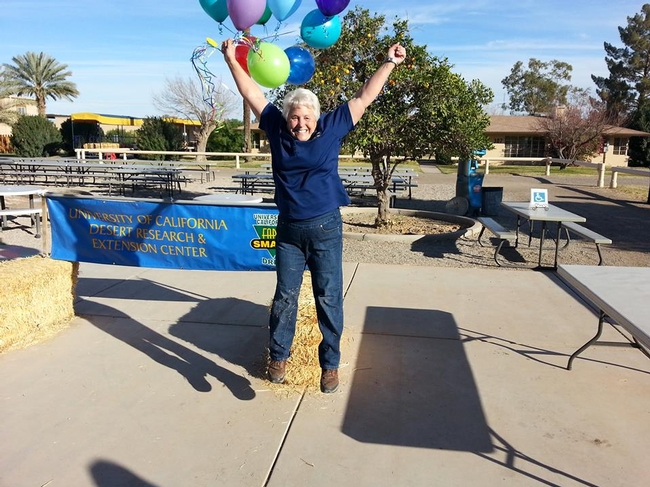
Nancy Caywood-Robertson jumps off a bale of hay at the UC Desert Research and Extension Center 'Farm Smart' celebration.
U.S. Rep. Juan Vargas visits the UC Desert Research and Extension Center
U.S. Congressman Juan Vargas (D-El Centro) visited the UC Desert Research and Extension Center last Friday to see the agricultural research underway, reported the Desert Review.
Vargas represents the 51st District, which includes portions of San Diego County, all of Imperial County and the entire U.S.-Mexico border in California. Desert REC director Sam Wang hosted the tour. He said the congressman posed for pictures with UC staff and academics, asked a number of questions and was very friendly.
ANR Vice President Barbara Allen-Diaz visited the congressman in his Capital Hill office in February and invited him to the research and extension in his district. The facility was established in 1911, making it the oldest ANR research center.
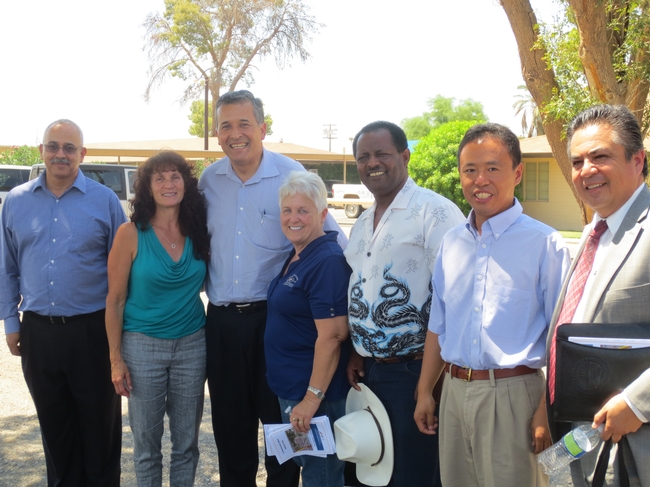
Left to right, Imperial UCCE director Khaled Bali, REC associate director Lisa Fisher, Congressman Juan Vargas, outreach coordinator Nancy Caywood, agronomy UCCE advisor Oli Bachi, DREC director Sam Wang and Vargas' field representative Rene Felix, .


